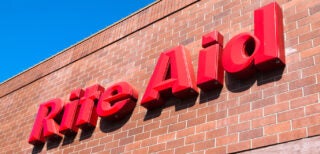- Resources
- Does Rite Aid’s new Chemical Policy bring us closer to a safer marketplace? Our take
Resources
Does Rite Aid’s new Chemical Policy bring us closer to a safer marketplace? Our take
Published: September 28, 2018 by EDF Staff
Earlier this month, the national drugstore chain Rite Aid released a new Chemical Policy and Restricted Substances List (RSL). Rite Aid joined a growing list of retailers taking action to ensure safer products for their customers. This public, written corporate chemicals policy communicates to Rite Aid’s suppliers, consumers, and other stakeholders that increasing Rite Aid’s assortment of safer products is important to the company’s mission.
How does Rite-Aid’s policy measure up?
Since Walmart released its ambitious Sustainable Chemistry Policy with a focus on safer products and transparency in 2013, we’ve seen a domino effect of other retailers such as CVS, Target, Home Depot, and now Rite Aid follow suit. Through EDF’s close collaboration with Walmart, we created the Five Pillars of Leadership framework to help other organizations eliminate toxic chemicals and create a safer marketplace. Many elements of EDF’s framework are reflected in subsequent retailers’ policies, including Rite Aid. Together, these retailers are amplifying the demand signal to the retail supply chain for safer chemicals in consumer products, particularly around 8 high priority chemicals (HPCs).
How does Rite Aid’s policy measure against EDF’s Five Pillars of Leadership?
- Institutional Commitment: Rite Aid’s written and public chemicals policy is a strong start to create an organization-wide commitment. The policy identifies goals around eliminating a set of 8 High Priority Chemicals (HPCs) from their private label formulated products as well as a timeline for this elimination. Rite Aid also states that they’ve been working with private label suppliers to eliminate these chemicals since well before they published the policy which further indicates institutional support for a policy. They also published a modest Restricted Substances List that contains other chemicals in the same chemical classes as their HPCs (e.g. formaldehyde donors and additional parabens). They committed to expand focus to national brand formulated products at their store. Finally, they set a timeline for expanding to other product categories, including food.
Rite Aid’s initial policy is strong. They can further enhance it by setting specific goals and timelines to help them “promote more comprehensive ingredient disclosure to consumers.”
- Supply Chain Transparency: Visibility into what’s in the products you sell helps you identify business risks and opportunities, and measure progress. Rite Aid is transitioning to the use of a 3rd party software tool called WERCSmart, that other retailers have also been using, to better screen product ingredients and track progress in eliminating their priority chemicals from their products. Rite Aid is asking all private brand suppliers to “report all ingredients in their formulated products” to WERCSmart. Importantly, Rite Aid will be looking at number of products containing these HPCs and number of suppliers using them. As we’ve discussed before, both metrics are critical for tracking the ubiquity of chemicals of concern in a retailer’s product portfolio and understanding on which product types to focus greater attention. Software tools are incredibly helpful in capturing ingredient information but a robust methodology for analyzing this information is essential to make improvements.
We recommend a few things to help Rite-Aid maximize the utility of its new tool. First Rite Aid should explicitly define their expectations for ingredient reporting (e.g., are generic ingredients allowed?). Rite Aid should also track weight volume reductions, which will be helpful in conveying the magnitude of their chemical footprint reductions as they head closer to full elimination of these chemicals from products. Finally, we encourage Rite Aid to track ubiquity and magnitude as measures of progress across suppliers and product categories as they expand focus to national brand products.
- Informed Consumers: Rite Aid states that it will promote increased transparency to consumers through “comprehensive ingredient disclosure” online or on product labels, including the components of fragrance ingredients and generic ingredients. They are also promoting third-party certifications like Safer Choice; the Safer Choice logo communicates clearly to a consumer that the product meets rigorous ingredient safety standards.

Rite Aid plans to communicate when products are free from certain chemicals of concern, though they don’t specify which chemicals they mean or how they will verify such information. As mentioned above, they also don’t set goals or timelines around increasing transparency. Doing so would create accountability for suppliers to act.
- Safer Product Design: Safer product design involves eliminating chemicals of concern from products and using demonstrably safer chemistry. Rite Aid identifies a number of ways they plan to achieve this. Interestingly, they target 8 HPCs to eliminate first formaldehyde, triclosan, toluene, butylparaben, propylparaben, dibutyl phthalate, diethyl phthalate, nonylphenol ethoxylates the same chemicals that Walmart and Target prioritized in their initial policies. Rite Aid also created a RSL, containing 69 other chemicals in similar chemical classes. Rite Aid plans to ask all suppliers to participate in the BPC Scorecard, including avoiding chemicals of concern on the BPC Stewardship List, which is pulled from six authoritative lists. Walmart, Target, CVS, and EDF were among the co-designers of this scorecard, an effort to establish common criteria for safer, more sustainable personal care products. As more retailers, like Rite Aid, implement the scorecard, the entire value chain will be pushed to achieve higher standards.
The policy also encourages the use of safer alternatives through resources like the U.S. EPA’s Safer Chemicals Ingredient List.
Rite Aid’s actions show a commitment to remove known carcinogens, endocrine disruptors, and reproductive toxicants from formulated products, which is especially important for these products that are used frequently on or around the body. We encourage Rite Aid to establish additional specific goals regarding the use of safer alternatives, perhaps collaborating on chemicals innovation efforts.
- Public Commitment: By publishing its policy, initial HPCs, and RSL Rite Aid has made a good demonstration of public commitment. They’ve also shared initial data around the reduction in use of these 8 HPCs by their private brand suppliers. And they’ve publicly committed to expanding their chemicals policy in 2019. These actions reinforce internal alignment on their goals, spur the innovation of safer chemicals needed to create safer products, and build consumer trust. Creating additional, public goals for other aspects of Rite-Aid’s policy will create a stronger demand signal for the entire value chain to act.
Overall, Rite Aid’s policy is a positive step towards bringing safer products to their shelves. We look forward to seeing their progress over time. As more retailers create chemical policies focused on transparency, safer ingredients, and public story-telling, we will get increasingly closer to a safer marketplace for all.
Follow Alissa on Twitter, @Alissa_Sasso
